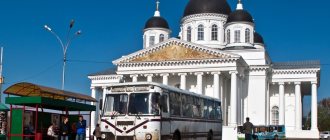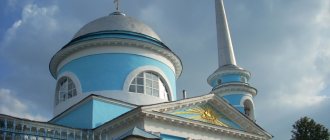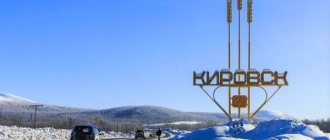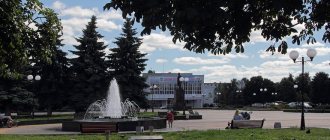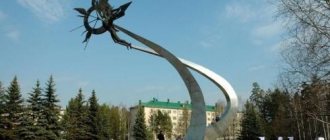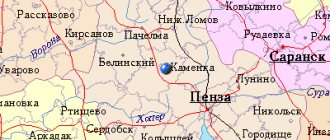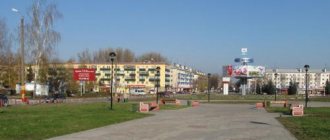The city of Semenov or “little Paris” is located in the very center of the Nizhny Novgorod region. A small but very beautiful town attracts with its rich, eventful history, original character, and abundance of attractions. Every year thousands of tourists come here to visit local museums, breathe fresh air, and get acquainted with the local culture.
The city has a rather interesting structure, for which it received its second name (“little Paris”). The settlement plan was approved by Catherine II. It had to be a huge square, which consists of 16 smaller squares. Two lines of streets were located diagonally, and at their intersection was the central square. Some of this structure has survived to this day.
Historical and Art Museum
The gallery was located in the house of the Old Believer Peter Sharygin in 1980. The exhibition includes more than 20 thousand objects of artistic and historical significance. Among them are the famous matryoshka doll, and objects decorated with the Khokhloma pattern, ancient house boards carved into wood, and wooden Russian spoons. A unique exhibit here is the work of the nuns of the Old Believer monasteries, namely their beadwork. In addition, here you can get acquainted with the history of the Old Believers in Semyonovsky district.
Location: Vaneeva street - 5.
Population[ | ]
| Population | ||||||||
| 1856[8] | 1897[8] | 1913[8] | 1926[8] | 1931[8] | 1959[9] | 1967[8] | 1970[10] | 1979[11] |
| 2800 | ↗3800 | ↗5100 | ↗6000 | ↗7500 | ↗19 837 | ↗23 000 | ↗23 633 | ↗25 199 |
| 1989[12] | 1992[8] | 2000[8] | 2001[8] | 2002[13] | 2003[8] | 2005[8] | 2006[8] | 2008[14] |
| ↗26 282 | ↗26 600 | →26 600 | ↘26 500 | ↘25 298 | ↗25 300 | ↘25 000 | ↘24 800 | ↘24 433 |
| 2009[14] | 2010[13] | 2011[8] | 2012[15] | 2013[16] | 2014[17] | 2015[18] | 2016[19] | 2017[20] |
| ↘24 351 | ↗24 473 | ↗24 500 | ↘24 433 | ↗24 442 | ↗24 503 | ↘24 451 | ↗24 583 | ↘24 536 |
| 2018[21] | 2019[22] | 2020[1] | ||||||
| ↘24 400 | ↘24 180 | ↘24 067 | ||||||
"The House of Semyon the Spooner"
The opening of this museum took place in June 2013. It is dedicated to the former life and work of Semenov’s craftsmen, of whom Semyon, the spoon maker, was a prominent representative. According to legend, Semyon, together with his wife and daughter, was engaged in making wooden spoons from birch and maple. These spoons were admired by everyone in the area, and thanks to this skill, Semyon, a spoon maker over a very large area, became famous. The museum hosts master classes and folklore concerts.
Location: Chkalova street - 18.
Content
- 1 Geography
- 2 History
- 3 Population
- 4 Heraldry
- 5 Administrative device
- 6 Economics
- 7 Minerals
- 8 Trade and services
- 9 Communications and telecommunications
- 10 Media
- 11 Transport
- 12 Education
- 13 Culture
- 14 Sports
- 15 Sights, museums
- 16 See also
- 17 Notes
- 18 Literature
- 19 Links
"Golden Khokhloma"
The Khokhloma painting factory was founded in the city in 1931. Currently, she produces dinnerware sets, candlesticks, painted furniture, vases and much more. In 2009, the “Golden Khokhloma” museum was opened at the factory, which displays all the objects painted with the Khokhloma pattern. Particular attention should be paid to the unique exhibits - huge spoons, chairs and cups. The museum hosts master classes on Khokhloma painting, as well as excursions for visitors.
Location: Chkalova street - 18.
Location and climate
The city is located in the Nizhny Novgorod region of the Russian Federation on the Sanokhta River. The regional center, Nizhny Novgorod, is 69 km away. You can get to it by highway to Kirov or by intercity train. In any case, the journey will take about an hour. According to Wikipedia, the area of the settlement is very small - only 14 km².
The climate in Semenov is temperate continental. Winters are long and frosty, with sub-zero temperatures often lasting from November to March. Summer is short but quite warm. The average temperature in January is - 9.3 °C, in July - 19.2 °C. Due to frequent cold spells, tourists are advised to visit the city only in the summer season - winters here are much harsher than in Moscow.
St. Nicholas Old Believer Church
This temple of St. Nicholas the Wonderworker is the main shrine of the city. It was founded in the first half of the 18th century and built in a style combining Byzantine and Russian elements. By the beginning of the last century, the church had become very dilapidated and in its place by 1916 a new brick building was built in the pseudo-Russian style. In 1938, the cathedral was closed, but in 1989 it was returned to believers and restored.
Interesting surrounding villages
The villages that are part of the Semenovsky urban settlement conceal a lot of interesting things. Those who are interested in the hidden corners of Russian history and culture should definitely take a look there.
Village Merinovo
- Coordinates: 56.784565, 44.610598.
It is believed that the legendary painted “Semyonovskaya nesting doll” was born in Merinovo. The name of the ancient village, according to one version, comes from the ancient “Meryan settlement” located here. The settlement is known as one of the centers of the Old Believers.
Bydreevka village
- Coordinates: 56.835264, 44.637197.
The settlement with a three-hundred-year history was mentioned in the story “The Reception” by the famous writer V. Korolenko. It became the starting point for the author’s journey along the Kerzhenets River. The main rural attraction is the Church of the Exaltation of the Cross, built in 1828. Local historians were able to establish that a wooden church previously stood in its place, dating back to the beginning of the 18th century.
The village of Sukhobezvodnoye
- Coordinates: 57.028148, 44.845085.
The history of the settlement is inextricably linked with the abbreviation GULAG, tragic for Soviet history. It arose in the 1930s as a logging settlement; the administration of the Uzhensky forced labor camp was located here. Among its prisoners were people of many nationalities, including Finns. In memory of the representatives of this neighboring people who died in the camp, a granite monument was erected on the territory of the village.
Village Kerzhenets
- Coordinates: 56.906546, 44.627917.
The settlement of the same name on one of the surrounding rivers is located on the railway route. Actually, the station is its main highlight. The building, recognized as a monument of urban planning and architecture, is the creation of a famous author - Alexey Shchusev.
All Saints Church
This is a brick cathedral, built on the territory of the cemetery in 1863. The building was erected in the Russian-Byzantine style. This is a single-domed quadrangle, which is connected through the refectory to a bell tower topped with an onion-shaped dome.
The church has two chapels - in the name of Alexander Nevsky and St. George's chapel. In the 30s of the last century, the shrine was closed and used as a water pumping station. In the 90s it was returned to the possession of the Russian Orthodox Church.
Heraldry[ | ]
Historical coat of arms of Semenov (1781)
The first coat of arms of the city of Semenov was approved on August 16, 1781[23].
The coat of arms of the Semenovsky urban district was approved on February 16, 2012.
The coat of arms is a heraldic shield bordered by a red stripe, consisting of two parts: in the upper part - “a scarlet (red) deer walking in a silver field, having horns with six branches and black hooves,” indicating belonging to the Nizhny Novgorod region, on whose territory the city of Semenov is located; in the lower part there is a fire made of logs stacked in a pyramid on a golden field, signifying the great importance of forests and woodworking in the life of the population. The dividing strip between the fields is red with an element of Khokhloma painting in gold, confirming the historical, cultural and economic significance of the folk craft[24].
Monastery New Sharpan
This monastery was founded by Old Believers in the 60s of the 19th century and was their refuge after the burning of the neighboring monastery by supporters of Nikonian reforms. In 1849, the icon of the Kazan Mother of God, proclaimed miraculous by the Old Believers, was removed from the monastery. As a result, the inhabitants of Sharpan moved to a neighboring monastery, which they called New Sharpan. Today it is for women, but even now you can come to it for worship.
Factory "Semyonovskaya painting"
- Address: st. Chernyshevsky, 1. Tel. +7 (83162) 2-22-72;
- Opening hours: daily from 10:00 to 16:00, Saturday from 10:00 to 13:00.
At the factory, tourists will learn the history of the appearance of the Semenovskaya matryoshka doll, get acquainted with the production process of various products painted with Khokhloma, and see the largest collection of nesting dolls, which includes not only dolls of traditional design, but also unusual detachable toys made to individual orders.
During the excursion, tourists are taken right through the factory, through the workshops where female artists and male turners work, that is, you can see the entire manufacturing process from turning blanks (there is some special word) to painting. Unfortunately, it is not possible to take photographs in the workshops, but it is very interesting to see.
The small Trans-Volga town of Semenov will long remain in the memory of guests as an amazing place with unique nature, complex history, original architectural monuments and talented craftsmen!
War Memorial
The granite monument was erected in Victory Park in 985 and is dedicated to local residents who died during the Second World War. The composition is a high pedestal made of red marble, reminiscent of the Soviet flag, on which the figure of a Soviet soldier is located. Opposite the monument the Eternal Flame burns, and nearby there is an alley on which busts of Heroes of the Soviet Union are installed.
Location: Chernyshevsky street.
Tourist information
Semyonov is a seemingly quiet and unremarkable town. The infrastructure here is not developed, there are practically no entertainment centers for youth, teenagers and children - only cultural monuments and folk craft centers are of interest. Tourists rarely stay in the city for a long time - they usually visit it as part of complex excursions around the Nizhny Novgorod region, staying for one night.
There are not very many hotels in Semyonov. The three-star Paris Hotel is located closer to the center - it is very close to attractions, which is why tourists often stay here. A little further away are the hotels “Nimbus” and “Owl”, which have lower prices. The Semenovsky Ark hotel has recently opened with a picturesque garden and terrace. There is also a recreation center with its own beach, “Yagodnaya Derevnya,” which is worth paying attention to for those who want to spend more time in the city.
There are not very many cafes, bars and restaurants in Semyonov. In the center there is an establishment with traditional Russian fast food under the authentic name “Teremok”. The only restaurant in the city, Krezhenets, is located nearby. At the local factory there is an inexpensive cafe “Khokhloma”. For lovers of Japanese cuisine, there is a place with the simple name “Semyonov Sushi”, from where you can order delivery. For those who prefer to cook on their own, you can shop at Magnit or Pyaterochka, or go to a local farmers market with natural products.
There are no large shopping and entertainment centers in the city. A lover of shopping and souvenirs should stop by the shop at the factory, where you can buy the famous Semyonovsky wooden products.
Monument to Three Communists
It was opened in October 1979 on one of the central squares of the city. The composition, 5 m high, represents the figures of three workers - communists, towering on a pedestal. These communists were I. Kozlov, A. Delfontsov and N. Zavyalov. It was they who made a huge contribution to the revolutionary struggle for Soviet power.
Every year today's communists gather at the monument, lay flowers at it and remember the years of the bygone Soviet period. People gave the pedestal the name “three men”, and the area around it – the area of “three men”.
Location: 3 Kommunistov street 29-31.
Attractions
The city of Semenov is a close interweaving of modern and historical attractions. Just walking along the streets, it is impossible not to pay attention to the ancient wooden houses, the windows and facades of which are decorated with elegant openwork compositions. The old provincial houses have been perfectly preserved to this day; they are located in the historical quarter. Their architecture harmoniously intertwines features of Byzantine, eclectic and original Russian styles.
Semenovsky Historical and Art Museum
This is one of the most famous and most interesting museums in Semenov. It is located on Vaneev Street in house number 5. Once upon a time it was the estate of the Old Believers merchants Sharygins. Since 1980, the funds of the Historical and Art Museum have been stored in a large two-story building built of red brick. One exhibition hall is dedicated to the life, everyday life and culture of the Old Believers. The largest and most interesting hall is the art room. Among the exhibits are Semenovsk toys, wooden products decorated with carvings, and works of local craftsmen who introduce visitors to the main crafts of the town. And the third hall is literary. Rare editions of books by local storytellers and poets are kept here.
Semyon Lozhkar Museum of Folk Life
It’s not for nothing that Semenov is called the “false capital of Russia.” According to legend, Semyon Lozhkar, together with his wife and daughters, was engaged in the manufacture and painting of original spoons made of natural wood. The master used mainly maple and birch. The products turned out to be very beautiful, practical and durable, and were distributed throughout Russia. The museum opened in 2013. Everything here resembles the traditional workshops of Semyonov craftsmen. The house and surrounding buildings are built of logs; inside there is an abundance of wooden exhibits, including, of course, wooden spoons, as well as musical instruments, household items, equipment for farming and cultivating the land.
Thanks to this Museum of Folk Life, visitors can get acquainted with Semenovskaya painting. Master classes are regularly held here and folklore concerts are organized. The museum is located on Chkalova Street and is open seven days a week.
Museum-tourist
One of the authentic attractions of the city of Semenov is the unique technology of Khokhloma painting. Once upon a time, this technique was used to finish dishes that were supplied exclusively to the royal and imperial dining rooms. After the collection of products was exhibited at the Paris Exhibition in 1889, products began to be made for export. The technology is truly unique and complex. To acquire the characteristic gilded color, the products undergo 5 stages of processing.
- The blanks, carved from dried linden, are covered with red-brown soil, they become similar to clay products.
- The second stage is impregnation with drying oil, rubbing with aluminum powder. The products acquire a characteristic matte-shiny silver hue.
- Next is the actual painting with special paints.
- Varnish is applied to the surface of the products.
- The specimens are baked in an oven at a temperature of 120 degrees, as a result of which they acquire a characteristic golden hue.
Along with the museum and tourist center, there is also a factory where they produce various products: furniture, ladles, spoons, panels, dishes, etc. Tourists will be told the history of Khokhloma painting, offered to master the technique, and shown theatrical performances.
All Saints Church
The religious monument was built in 1863 on the territory where the cemetery used to be located. Brick was used for construction. The architectural style of the building is Russian-Byzantine. The church is a single-domed quadrangle connected to the bell tower through a refectory. The domes are made in the shape of an onion.
The memo has two chapels: St. George's and Alexander Nevsky. It did not always serve as a shrine. In the 30s of the 19th century there was a water pump here. In the 90s, the church was returned to the ownership of the Russian Orthodox Church.
St. Nicholas Old Believer Church
The Church of St. Nicholas the Wonderworker is the main religious monument of Semenov. The temple was founded in the 18th century. Its architecture combines features of Byzantine and traditional Russian styles. At the beginning of the 19th century, the building was badly damaged, so it was decided to build a new one in its place. In 1916, on the site of the old, dilapidated church, a new brick temple, decorated in pseudo-Russian style, stood. For half a century (from 1938 to 1989) the cathedral did not function. Only in 1989 it was returned to the parishioners, restored, and the work of the shrine was resumed.
Train Station
The large, modern building of the new railway station was opened in June 2006. The total area of the premises is 4250 m². More than 300 people can fit inside. There are three floors here. The facade is made in pleasant light colors. The premises are decorated in white and blue tones. The architectural composition is complemented by a sea-green roof. The internal space of the railway station is divided into functional areas: halls for passengers with children, sanitary facilities, a buffet, a hall for long rest, a waiting room, etc. Outside there is the main platform and platform.
Estate G.A. Vitushkina
G.A. Vitushkin is one of the famous spoon makers of the city of Semenov, who owned an entire workshop. Vitushkin's house was built in the 19th century. The building was erected from red brick and has perfectly preserved its properties to this day. A small estate on two floors with large windows is made in traditional Russian style. The object attracts with its elegant architectural forms. The facade is plastic, the windows are decorated with an arch. At the entrance to the territory there is also a massive gate arch. The building is decorated with decorative elements: projections, pilasters, recesses, etc. Today the house houses a federal post office.
Monument to Soldiers - Internationalists
The memo is located in a park near the main administrative facilities of the city. The monument was erected in honor of the soldiers who died in the war in Afghanistan. Every year, on the day of the withdrawal of Russian troops from the territory of hostilities, a memorial service is held here, the heroes who died in hot spots are honored. The monumental composition consists of two steles of equal size. They are made of black granite. The steles are connected by a chain, on which, and on it - a golden bell. The lower part of the monument is a stone with memorial plaques. The monument is fenced; fresh flowers are often brought here.
Monument to Three Communists
I. Kozlov, A. Delfontsov and N. Zavyalov are ordinary workers who were fans of the Communist Party. They became a kind of prototype for all communists in the city of Semenov. The sculpture is located on one of the central squares; it was solemnly opened in 1979. The ensemble consists of 5-meter figures of three men standing on a pedestal. It is believed that the heroes of this monumental composition made a great contribution to the revolutionary struggle for Soviet power. Every year people gather here to honor the memory of that period and those communists who are no longer alive. The popular name of the monument is “three men”, and the square on which it is located is “three men”.
War Memorial
On Chernyshevsky Street in Victory Park there is a monument to the soldiers who died during the Second World War. The monument was opened in 1985. The base of the composition is a high pedestal made of red marble. In appearance it resembles the flag of the Soviet Union. On the pedestal is the figure of a young soldier. There is a plaque at the bottom of the monument. Opposite the monument is the Eternal Flame. A few meters from here there is an alley where busts of heroes who gave their lives in the war are installed.
Monastery New Sharpan
Skete New Sharpan was founded by representatives of the old rituals in the 60s of the last century. They lived here after fans of Nikonian reforms burned the neighboring monastery. Until 1849, there was a miraculous icon of the Kazan Mother of God here. This monastery is for women. Residents lead a hermit lifestyle, maintaining and developing their traditions and customs. Tourists come here on an excursion or to worship. Old Believers live in small houses built of wood.
Monument to Soldiers - Internationalists
The monument, located in a small park not far from the administrative buildings of the city of Semenov, is dedicated to the soldiers who died during the years of hostilities in Afghanistan. Every year, on the day of the withdrawal of Russian troops from Afghanistan, a memorial service is held here for the heroes who fell in hot spots. The composition consists of two steles made of black granite, connected by a chain on which a bell hangs.
Location: Zavodskaya street.
Administrative device[ | ]
Monument to the poet Boris Kornilov
| The section lacks links to sources. Information must be verifiable or it may be deleted. You can edit the article to add links to authoritative sources. This mark was set on April 9, 2014 . |
The city center has a fairly orderly planning structure that developed in pre-revolutionary times. The other microdistricts of the city that currently exist have appeared since the middle of the last century.
Microdistricts:
- Center (often called the City, a historically developed area of the city. Currently, it houses almost all government institutions, many shopping centers. The residential area is represented mainly by private houses and a small number of apartment buildings);
- Dyakovskoe Pole (the most populous microdistrict in terms of number of residents. The residential area is represented mainly by five-story residential buildings. Active development began in the 1990s and continues to this day);
- New construction (the area was built up in the 1950s-1960s, it was then that the name arose. The housing stock is private houses);
- South-Eastern microdistrict (an area actively under construction, which began to be built up at the end of the 20th century. The housing stock is individual houses and cottages);
- Purekh (the area is represented by two main streets, with small streets diverging from them. The housing stock is private houses, with a small number of apartment buildings).
- Microdistrict of Zavodskaya Street (housing stock - low-rise apartment buildings).
All neighborhoods are connected by public bus routes.
Estate G.A. Vitushkina
Vitushkin was the owner of a spoon fishery. His house, built of red brick, was erected at the end of the 19th century. It is made in a style typical for the construction of small estates, characteristic of the end of the 19th century.
The building is unique due to its pronounced plasticity of the facade, as well as the massive arch of the gate. The building is richly decorated with numerous decorative elements. Currently, the Vitushkin estate houses the federal post office.
Location: Lenin street - 23.
History[ | ]
It arose at the beginning of the 17th century as a settlement of Old Believers, first mentioned in 1644 as the village of Semenovskoye
, in 1717 - the village of
Semyonovo
.
Since 1779 - a district town of the Semenovsky district of the Nizhny Novgorod governorship (since 1796 - Nizhny Novgorod province). Lozhkarny market in Semyonov.
Beginning of the 20th century. Photo by M.P. Dmitriev Carved spoons and “chips” goods (trays, cups, tuesa, etc.) were brought from surrounding villages to Semyonov, which, after finishing and painting, were sent to the Nizhny Novgorod fair.
In the 19th - early 20th centuries - the center of the Old Believers, the only place in Russia where leather rosary beads were made for Old Believers[5].
In 1920, the suburban village of Purekh (Purekhskaya Sloboda, Zamostnaya Sloboda) became part of the city[6].
On April 8, 1968, the suburban villages of Khvostikovo and Maloe Vasilyevo became part of the city of Semenov[7].
Transport[ | ]
Old Believer Church in the name of St. Nicholas the Wonderworker City of Semyonov.
October Revolution Square. A monument to three communists who died in 1919 in a battle with counter-revolutionary bandits hiding in the forests near the village of Olenyevo. (1979) Outside the city there is a highway of regional significance Nizhny Novgorod-Kirov. There is a railway station on the new direction of the Trans-Siberian line. Electric trains run to Nizhny Novgorod approximately every hour. Travel time is about 1 hour. The fare is 160 rubles. There is one train stop within the city - platform 506 km, connecting the station and the central part of the city with the Zavodskaya Street microdistrict.
Transport within the city is carried out by JSC Semenovsky Autopark and a small number of private carriers. The bus station is located in the railway station building. There are city, suburban and intercity routes.
The traffic situation on the streets is usually free; there may be minor traffic jams only during rush hours in the central part of the city.
Education[ | ]
In Semenov there are four secondary schools, an Orthodox gymnasium named after. St. Apostle and Evangelist Luke, evening school, Lyceum named after. A. S. Pushkin.
State educational institutions of vocational education:
- GBPOU "Semyonovsky Industrial and Art College" (GBOU SPO SIHT).
Branches of higher educational institutions:
- Semenovsky branch of Nizhny Novgorod State University named after. N. I. Lobachevsky
Notes[ | ]
- ↑ 123
Population of the Russian Federation by municipalities as of January 1, 2022 (Russian). Date accessed: October 17, 2022. Archived October 17, 2022. - THE USSR. Administrative-territorial division of the union republics on January 1, 1980 / Comp. V. A. Dudarev, N. A. Evseeva. - M.: Izvestia, 1980. - 702 p. — P. 118.
- Law of the Nizhny Novgorod Region dated December 22, 2010 No. 211-Z “On the transformation of municipalities of the Semenovsky municipal district of the Nizhny Novgorod Region”
- Law of the Nizhny Novgorod Region dated December 22, 2010 No. 212-Z “On changing the administrative-territorial division of the Semenovsky District of the Nizhny Novgorod Region and on amending Article 11 of the Law of the Nizhny Novgorod Region “On the administrative-territorial structure of the Nizhny Novgorod Region”” (unspecified)
(inaccessible link) . Access date: April 9, 2013. Archived January 16, 2014. - Kudryavtseva K. G.
Kerzhenets - the promised land // Materials of the round table on the Old Believers - History of the administrative and territorial division of the Nizhny Novgorod province 1917 - 1929. - 1983. - 292 p.
- Administrative - territorial division and authorities of the Nizhny Novgorod Territory - Gorky Region 1929 - 1979. - 1984. - 264 p.
- ↑ 1 2 3 4 5 6 7 8 9 10 11 12 13
People's encyclopedia “My City”.
Semyonov (city) (undefined)
. Retrieved June 17, 2014. Archived June 17, 2014. - All-Union Population Census of 1959. The size of the urban population of the RSFSR, its territorial units, urban settlements and urban areas by gender (Russian). Demoscope Weekly. Access date: September 25, 2013. Archived April 28, 2013.
- All-Union Population Census of 1970 The size of the urban population of the RSFSR, its territorial units, urban settlements and urban areas by gender. (Russian). Demoscope Weekly. Access date: September 25, 2013. Archived April 28, 2013.
- All-Union Population Census of 1979 The size of the urban population of the RSFSR, its territorial units, urban settlements and urban areas by gender. (Russian). Demoscope Weekly. Access date: September 25, 2013. Archived April 28, 2013.
- All-Union population census of 1989. Urban population (undefined)
. Archived from the original on August 22, 2011. - ↑ 1 2
All-Russian population census 2010.
Number and distribution of the population of the Nizhny Novgorod region (unspecified)
. Retrieved July 30, 2014. Archived July 30, 2014. - ↑ 12
Nizhny Novgorod Region. Estimated resident population as of January 1, 2008-2016 - Population of the Russian Federation by municipalities. Table 35. Estimated resident population as of January 1, 2012 (unspecified)
. Retrieved May 31, 2014. Archived May 31, 2014. - Population of the Russian Federation by municipalities as of January 1, 2013. - M.: Federal State Statistics Service Rosstat, 2013. - 528 p. (Table 33. Population of urban districts, municipal districts, urban and rural settlements, urban settlements, rural settlements) (undefined)
. Retrieved November 16, 2013. Archived November 16, 2013. - Table 33. Population of the Russian Federation by municipalities as of January 1, 2014 (unspecified)
. Access date: August 2, 2014. Archived August 2, 2014. - Population of the Russian Federation by municipalities as of January 1, 2015 (unspecified)
. Access date: August 6, 2015. Archived August 6, 2015. - Population of the Russian Federation by municipalities as of January 1, 2016 (Russian) (October 5, 2018). Retrieved May 15, 2022. Archived May 8, 2022.
- Population of the Russian Federation by municipalities as of January 1, 2022 (Russian) (July 31, 2017). Retrieved July 31, 2022. Archived July 31, 2022.
- Population of the Russian Federation by municipalities as of January 1, 2022 (Russian). Retrieved July 25, 2018. Archived July 26, 2022.
- Population of the Russian Federation by municipalities as of January 1, 2022 (Russian). Retrieved July 31, 2019. Archived May 2, 2022.
- Coats of arms: Semyonov city and Semyonovsky district
- Coat of arms of the Semyonovsky urban district
- Archbishop George celebrated the Liturgy of the Presanctified Gifts at the All Saints Church in the city of Semenov (photo) (unspecified)
. Nizhny Novgorod and Arzamas diocese (March 5, 2010). Access date: March 14, 2010. - The opening of the “Museum of Matryoshka Dolls and Traditional Toys” took place in Semenov
. Tourist portal of the Nizhny Novgorod region (11/27/2017).
